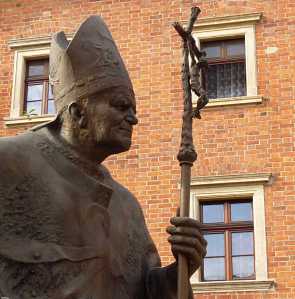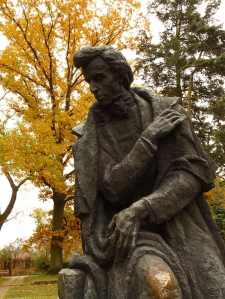- The country went through unimaginable horrors in the 20th century. World War II took a terrible toll on Poland and its people, and then they had to deal with decades under Soviet influence. This is a land with sad sad stories. They are visible everywhere on the streets in Warsaw – including the plaques on the walls of buildings in the main streets recording massacres by the Nazis, the haunting memorial that was the HQ and grave of the fighters of the Warsaw Ghetto Uprising and is built from the rubble of the street, the signs indicating the location of the Ghetto Wall, the infamous prison and the domineering communist-era building overlooking the city (the Palace of Culture and Science).
- And of course, we can never forget Auschwitz-Birkenau.
- The Church. Catholicism has survived intact in Poland, and churches abound. (Though sadly, they are not always aesthetically pleasing.) From Poland, Pope Jean Paul II (Karol Józef Wojtyła) was the first non-Italian pope since 1523, and statues – both good and bad (clearly depending on the budget) – of him are everywhere.
- Handbag heaven. I thought I would buy an Italian leather handbag when in Italy. I learned early the most important sentence in Italian: “Quanto costa questa borsa?” (How much is that handbag?) But I’m not much of a shopper when I am travelling, and when my friend from Warsaw visited us in Puglia, I was lamenting the fact I still had not purchased my Italian handbag. “Don’t!” she advised. “Buy it in Poland. There are good, leather, handbags at very reasonable prices.” She was right …
- Chopin. I have played a lot of Chopin on the piano. And though I didn’t get time to visit the Chopin museums in Warsaw, it was a special pleasure to visit his birthplace on a Sunday afternoon. The large gardens are beautiful to stroll through, and you can sit on a bench and listen to Chopin piano pieces on speakers. It was packed with people, to my friend’s surprise. Which brings me to the next item …
- Autumn colours. We realised, after leaving Chopin’s birthplace and visiting a palace a few miles down the road, that this is what the locals do in October, much as we visit the tulips in Wellington’s gardens in spring (and starved as we are of autumn colours in our green city). According to a new friend who helped us understand the entrance fees, once a year the locals visit beautiful gardens, and take in the sheer gorgeousness of the autumn colours. Couples strolled, or sat in a golden haze reading. friends chatted arm in arm, and children played in the leaves. The light changed the colours, from green to yellow to orange, red and brown, as we moved around the estate. And as dusk fell, it was time to leave.
- Krakow. It deserves its reputation as a highlight of Poland. There is real rivalry between Krakow and Warsaw – the locals believe there is a reason that the train to Warsaw leaves from the most distant platform at the station! Krakow was the capital before Warsaw, and escaped destruction in WWII. Its Old Town is therefore beautiful, its Castle remains intact, the ghetto and Schindler’s factory remain. One of the oldest universities in the world provides plenty of students who enliven the square (flash mobs dancing or rollerblading in the evening) and are a plentiful supply of English-speaking labour for the tourist industry.
- Warsaw. It’s the poor cousin to Krakow in tourist terms, and so is often left off visitor itineraries. Unfortunately the most picturesque town square was being maintained when we were there, but the reconstruction of the Old Town is extraordinary, and conveyed, to me, an extraordinary spirit of both pride in their past, and hope for the future. That hope is now obvious in this vibrant city; the home of Copernicus (The husband can vouch for the Science Museum) and Chopin, with beautiful parks, a castle, interesting and inspiring museums, it is well worth a visit.
- Stay in a castle. When it is cold, because castles should be cold, and the roaring fires in the bar are cosy. Preferably it should be haunted too. Just because. Our castle, in the lakes district and near Hitler’s wartime HQ, also gave us the opportunity to stay in a small village, and to see some of the countryside.
- Time. You need more than two weeks to do credit to Poland. We spent five days in Krakow, three days in the beautiful lake district, and seven days in Warsaw. We didn’t get to Gdansk, or unfortunately to Schwersenz, the town near Poznan where The Husband’s great-grandmother was born, before she set off at the tender age of 18 to migrate to New Zealand. So maybe, one day, we might have to go back.
Nov5










































Growing up near Chicago I had the pleasure of knowing many Poles but Poland was never a place on my to-visit list. Until now. Thanks Mali!
I’m inspired. Your photos are wonderful.
Stunning photos — especially the ones of the autumn colours (for good reasons) & Auschwitz (stark & sad). The suitcase photo in particular made me think of the story of Hana’s Suitcase — have you ever heard of it? Amazing story.
http://en.wikipedia.org/wiki/Hana_Brady
http://www.hanassuitcase.ca/
Same here. The Polish tourist bureau should hire you, Mali.
These photos are fantastic. Thanks, Mali!